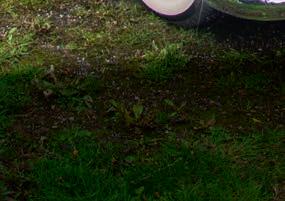
15 minute read
From the archive

ONE HOT LUMP, PLEASE










50 years ago: Custom Car, December 1972
Half a dozen pages ago, you’ll fi nd Keith Lee’s story about the exploits of the much loved Stones racing team. By a strange coincidence, exactly 50 years ago Custom Car featured its fi rst ever front cover engine pic – and was one of their engines. The 427 Chevy which helped the team’s legendary Tee Rat to become the UK’s fi rst altered to run in the 7s, it was brought to our studio by Dave Stone and ended up being photographed for the best part of a day. The reason?
Custom Car’s staff had been getting down and dirty
with the whole subject of engine building – and this here article was the result. It may have dated badly, and the prices quoted in it will make you hoot, but like every item in our Archive series it’s a piece of history that helps make sense of the present – and even today, it’s an informative read by anyone’s standards
Note: This article quotes a number of prices, all of them based on
the market as it was in late 1972. Infl ation over the course of the intervening half-century means that £1000 then is equivalent to approximately £10,500 now



A drag motor sitting pulsating on its mountings looks externally very much like its close friend that never gets further than the engine bay of a family sedan. Just what is it that makes an American V8 hurl a dragster up the strip so fast?
To fi nd out, we spent a couple of days pumping Dave Riswick at John Woolfe Racing for all the info. Spent a fair time in the parts shelves too, digging all the Stateside goodies out of their cartons. We knew we’d never get the complete story down here in a meagre couple of pages – that’d take about three books – but what we did fi nd out was the general way that the planning for a competitive drag engine should be formulated.
The factors involved are the monetary budget and the decision whether to run the motor as a fueler (running nitro or a similar fuel) or a gasser (running on regular pump petrol) or maybe even with the capability of changing from gas to fuel somewhere along the line. Budgeting for the engine will dictate just what can be built up: £500 will build a conventionally aspirated engine with either a single or a multiple carburettor set-up and all the good things that live in the block to make it go and prevent it from blowing itself up too often; up to £1500 and not less than £1000 is going to build you a fuel injection engine of the same standard.
Finally, the big jump to a supercharged and injected lump. Well, if you get it done right it’s going to bust you at least four grand and probably more.
With a blown set-up, the power will shred any standard drivetrain. So what Dave terms a ‘super bulletproof’ transmission, clutch and axle must be added to the cost on top of the engine. Note that it’s not necessary to make a tough gearbox, however, as most top dragsters are driven direct.
Many diff erent engines are used for drag racing but the best known ones are the small and big block Chevys and the big Chryslers, and these will do just fi ne as examples for this article.
For performance gained per pound, the small-block Chevy shows up as the engine to go for, at least up to our limit for stack-type fuel injection. After that, when you’re up in the supercharger bracket, the added strength of the big Chrysler makes it desirable property. No reason why anyone should avoid blowing a Chev lump though, because plenty of people have done it successfully.
Chevrolet’s famous series of small-block V8s started with the 265ci version way back in 1955. Over the years, this basic engine has been increased in size right up to 400ci. The popular sizes that have appeared in the intervening years have been the 283, 302, 307, 327 and 350ci versions which have enjoyed great popularity with both the Hot Rod and the Trans Am set.
Adhering to the budget, you’d probably search for a used motor or block assembly to cut the cost of the build-up. From 1955, the internals of all the engines were basically the same and most parts were interchangeable until around 1967, when the crank journal sizes of the 302 and 350 were changed. Around that time, four-bolt main bearing caps were introduced, too.
Used engine prices rather depend on whether the guy selling it knows just what potential his oily great lump of American iron really has. You could be lucky and pick up a very useable engine anywhere from £25 through to £150. The later the engine the better, and



Chevy small-block, left cylinder bank
Holley plus Edelbrock – set-up for a big power increase
Underside of unmounted Holley 800 double pumper and Edelbrock Tarantula manifold





identifi cation of the valve cover bolts will help here.
The line of bolts was staggered on the 265 engine, but went over to a straight pattern in mid-1959 on the 283, and all the 327 and later engines featured the same style. ou can also help yourself to place an engine by learning to identify heads. arly ones had very small ports and bare cast ends, but the next series had larger ports and featured a triangular bump on the ends of the heads. The third series had two bumps, and are the best.
The 327 high-performance engine fi rst appeared in the Corvette in 1962, and the heads on it were rather special. They had 2.02in inlet valves and 1.625in exhaust valves, and some of them sported the latest type Rochester fuel injection. The ones that did were known as ‘fuely heads’ and at the time they were the very last thing in production performance modifi cations. f you fi nd a set, you’re on to a very good thing. ngine mounting points also help to date an engine. f there is no mounting between the core plugs on the side of the engine, then it’s an older one, and not as desirable as the later models which have triangular fi xing points.
Okay. Having found an engine, let’s say a 350ci of ’68 vintage, we need to know the basic re uirements for making it get up and go. f it’s what M called a ’High Output’ unit, it’ll have a good alloy inlet manifold as standard and probably a big Holley carb too. f it doesn’t have a Holley, it needs one the right one, please. f it’s just a standard engine, though, featuring a cast iron manifold, the fi rst task is to give the iron the big heave and substitute either the factory alloy one or one of delbrock’s -choke aluminium Tarantulas, which will give around a 53bhp increase over the production iron eff ort. Costs around £55 over here. f you really feel you need that cast iron manifold, though, you could retain it and add the latest trick Holley a spread-bore carb with four chokes, specially made to fi t that good ole cast iron.
Assuming for the moment that we’re using the alloy factory manifold, a single four-barrel double-pumper carb is a pretty good idea. A double-pumper operates in very much the same fashion as a progressive choke carburettor, except that it has four choke bores and a mechanically operated second opening, which injects neat fuel through four nozzles when you bury your foot in it.




Standard 2-bolt main block
Top view of 6/71 supercharger



This gives instant throttle response without ‘bogging’ and is in eff ect very much like fuel injection. Adoption of this type of carburettor will give smooth, progressive power right up the range.
The popular Holley carburettors ow between 700 and 800cfm cubic feet per minute while the top of the line Dominator 500 can ow 1150cfm, although it’s only really for the ultimate in competition use. A pair of vacuum 600s on a twin-tunnel ram manifold is about the tops for a gas set-up. Fuel can certainly be run through carburettors, though a needle and jet change would be necessary not only for reasons of size but because they’d need to be made of diff erent material.
At this stage, if it’s felt that still more power is needed then the switch to full stack type port injection has to be considered and this is where the big money starts getting spent. For instance, a new front cover to make provision for the fuel pump drive from the cam nose will be about £30. A full injection system is going to cost between £250 and £350 maybe even more. f you’re going to mess about experimenting with adjustments, you’re going to need some more sets of nozzles. They’re around £35 a set, by the way.
An engine built for gas operation can also be run on a fuel mix of up to 0 in certain cases, if the injection nozzle sizes are changed. The fuel mix really has to gush into the combustion chambers as it’s not as volatile as petrol. Any increase over 0 in that mixture strength is going to lead to all the weird problems that one meets with a fuel engine.
Head modifi cation on an engine to this stage is fairly straightforward. The chambers should be checked to ensure that they’re all the same capacity about 60-70cc is usual. They should be polished and ported, and the sort of standard reached should be about the same as roup 2 circuit racing car engines. Compression ratio is usually pegged at 12.5 1. The spring pads on top of the heads have to be machined down to accommodate larger valve springs and it’s usual to fi t Teflon oil seals to the valve stems.
On most stock Chevy engines, the rocker arm studs are only press fi tted, but kits are available to convert them to screw-in type. The studs go into the water jacket, so plenty of sealer should be used
Okay, so we’ve now reached the stage where much more work on a small block Chevy could result in the unreliability of the engine. So on to supercharging but start thinking in big-block Chrysler terms.
The typical supercharger for high performance application is the MC 6 71, usually coupled with one of the many fuel injection systems available. asically the 6 71 is a commercial supercharger used for trucks and earth moving e uipment. As it’s designed only for operation at a puny 3000rpm, many mods have to be incorporated before it can be run as a full house race engine blower. Standard cast gears are replaced by steel components for a start, and the top and the exhaust side of the outer casing are machined out for more air ow. oth the induction rotors and the blower case are relieved and remachined for better tolerances. The rotors are grooved to accept Te on inserts for better sealing and are pinned front and rear to prevent them slipping on their shafts. The rotors and shaft are then repositioned to gain proper tolerances at the top and the bottom of the case.
Te on buttons at the end of the rotors prevent end-on contact with the front and back plates of the blower housing, these plates also being re-pinned for accurate location. Rear cover plates are heavily webbed for extra strength and the front bearing plates are beefed up so that they can take the extra load imposed by the larger bearings.
With all this extra attention involved in the rebuilding of a supercharger for competition work, it’s small wonder that the ex- S price is close on £300. Ancillaries for this installation run to the blower manifold, probably about another £80, and the drive kit which has the blower nose casing, belts and pulleys to connect the top unit to the crank. Count £175 for that lot.
The crank hub itself is a must, and this is very costly because it’s precision made from very high grade steel. Should cost around £30. Add that to the £250-£300 we already know about for the injection system, and you begin to see where all that £1500 went.
There, then, are the three kinds of induction system that govern the budget of an engine build. And that’s before you start looking into the actual operation of the engine itself, and what makes it all hang together when it’s built for pure performance



Above: Steel crank for small block Chevy
Below: 6/71 blower with Hilborn injection and air ram






DECEMBER 2022 £4.99
Winter ’23 issue on sale 24 November











To pre-order the Winter issue, visit www.amedia-shop.co.ukComing next month
All prices include VAT. Prices subject to change without notice. Correct at 15-3-22. E&OE. Freight extra.
Front wings 64-68 ......... fr£170.78 Bolt & clip kit, top ............ £18.90 Splash shields 64-68 ........ fr£23.15 Rad panel 64-68 ............ fr£177.79 Front valance 64-68 ....... fr£61.70 Fr frame rails65-70 ......... fr249.67 Rr fraim rail 65-68 ....... fr£292.78 HD 3cor US rad64-6........ £450.30 Rad hose kits 64-8 ............. £30.88 Heater seals 64-66 ............. £17.63 Htr plenum 64-68 .............. £25.58 Heater cable set 64-6 ......... £20.06 Heater rads 64-73 ........... fr£45.18 Htr core end caps 65-8 ...... £11.09 Therm housin 64-73 ...... fr£19.01 Shroud-fan-steel 64-6 ........ £30.59 Rack & pinion kit, manual, 65-66 ......................................... *£981.00 Power rack&pinion conv kit, 6570 inc pump .............. *fr£1423.42

V/reg inst panl 64-8 ........ fr£38.95 Park light kt 64-66pr ........ £76.90 Reverse lt kit 64-6 ............. £72.32 Numb plat lit 64-70 ........... £33.71 Indicator switch 65-6 ........ £31.30 Dipswitch 64-73 .................... £7.74 Latch or lock 65-68 ....... fr£59.23 Door lk knob 64-7pr ......... fr£5.48 Chrm gromet 65-68 .......... pr£4.42 Door card clips 30........... fr£14.84










